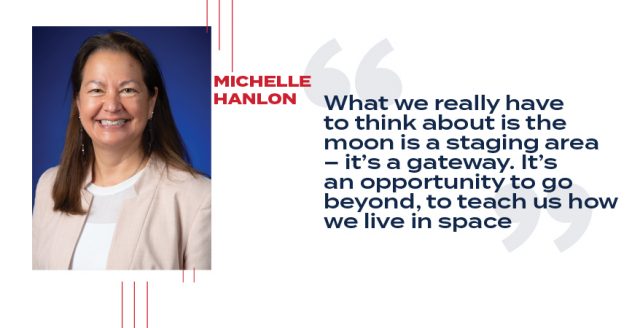 OXFORD, Miss. – When India’s Chandrayaan-3 spacecraft landed on the moon Wednesday (Aug. 23), it was not only the first time a craft safely made it to the lunar south pole; it marked a shift in global power, said Michelle Hanlon, executive director of the University of Mississippi Center for Air and Space Law.
OXFORD, Miss. – When India’s Chandrayaan-3 spacecraft landed on the moon Wednesday (Aug. 23), it was not only the first time a craft safely made it to the lunar south pole; it marked a shift in global power, said Michelle Hanlon, executive director of the University of Mississippi Center for Air and Space Law.
Since Apollo 11’s historic landing in 1969, only two other countries have successfully touched the lunar surface: Russia and China. The three global superpowers have reigned supreme in the space race for more than 50 years, “so much so that when India announced it was going to the moon, Russia tried to beat them to it because they wanted that prestige,” Hanlon said. But India’s feat changes that dynamic.
“I see this as a shakeup in the world order,” she said.
Russia’s Luna 25 probe crashed into the lunar surface, but Yuri Borisov, chief of the Russian space agency Roscosmos, said in a recent televised interview that a new space race has begun.
The lunar south pole represents a bigger question to space law and to humanity, said Hanlon, who is co-founder and CEO of For All Moonkind, a nonprofit organization that advocates for the protection of historic lunar landing sites.
The south pole is one of the few areas on the moon with significant amounts of water ice, a resource that could be used to help create more lasting human habitation on Earth’s natural satellite. Craters at the poles also are the only places that receive constant sunlight, making the south pole a perfect location for solar-powered devices.
“What we really have to think about is the moon is a staging area – it’s a gateway,” the Ole Miss professor said.
A permanent lunar settlement could teach researchers about the effects of living in space and the psychological needs of humans living in an inhospitable atmosphere, she said.
“It’s an opportunity to go beyond, to teach us how we live in space,” Hanlon said. “It’s a gateway to the cosmos.”
With Chandrayaan-3’s successful landing, who, then, owns the vast quantities of ice and ideal research conditions near the pole? What law prevents India from laying claim to those resources or another nation taking it from them?
“We don’t know,” Hanlon said. “These are the things we have to be discussing. Sticking a landing on the south pole and being the first to do it means we really have to take notice.
“It brings a sense of urgency to space law.”
Though India is a member of the Artemis Accords, a series of principles guiding the civil exploration of space, that agreement is not binding.
“The principles there are great, but there’s nothing to say now that India’s there, China can’t just go land right next to them,” she said. “We really have to lay down the law about what it means to be putting robots in close proximity to each other on the moon.”
Though the landing is fraught with questions, it is a great human achievement and a step toward diversifying the realm of space exploration, Hanlon said.
“Looking back in history, this will mark the beginning of an entire new era in space exploration,” she said. “Think about Antarctica – 20 years ago, it was just outposts, and now tourists are there.
“We’re making those steps to make the moon accessible.”